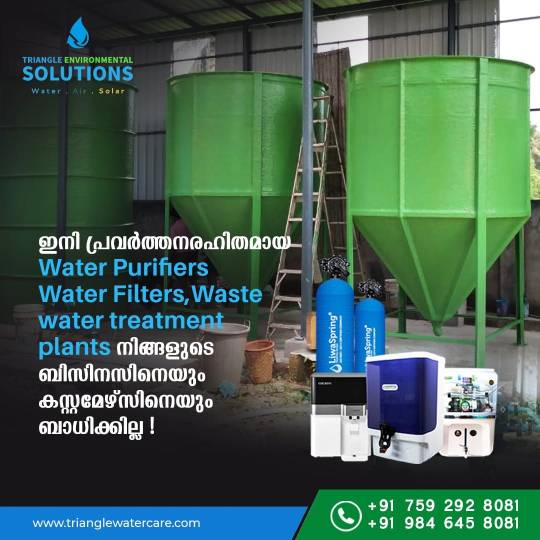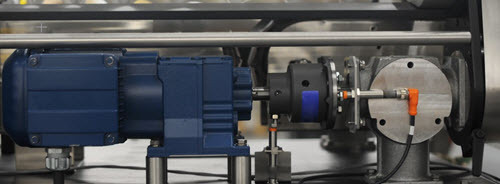#sewage water plant
Explore tagged Tumblr posts
Text
"𝐏𝐚𝐜𝐤𝐚𝐠𝐞𝐝 𝐒𝐞𝐰𝐚𝐠𝐞 𝐓𝐫𝐞𝐚𝐭𝐦𝐞𝐧𝐭 𝐏𝐥𝐚𝐧𝐭"
LARCO India Pvt Ltd is a leading provider of Packaged Sewage Treatment Plants in India. We recognize that each client has unique requirements when it comes to sewage treatment. Our team of experts works closely with you to understand your specific needs, water volume, quality standards, and local regulations. Based on this analysis, we design and deliver customized sewage treatment solutions that address your specific challenges.

#sewage treatment plant#stp#wastewatermanagement#water treatment plant#water recycling#sustainability
2 notes
·
View notes
Text
i’m honestly so shocked that rick hasn’t written percy being cornered in a water treatment plant and using untreated poop water to attack monsters
#i really that that happened#eat shit#literally#pjo#percy jackson#rick riordan#percy jackson and the olympians#water treatment plant#sewage treatment plant#poop water#idk could be fun#maybe in the next one#wrath of the triple goddess
6 notes
·
View notes
Text

We would like to extend our heartfelt thanks to our best and most valuable customers for your unwavering trust and support throughout 2024. Your loyalty has been the cornerstone of our success. As we close this year, we reflect on the incredible journey we've shared and look forward to even greater achievements together.
May the upcoming year bring you continued prosperity, growth, and happiness. Wishing you a wonderful New Year filled with new opportunities and success!
☎️ More Information
📱 +91 9953088849, +91 062043 85227
🌐 www.a1blowers.com
#dewatring #sewagetreatmentplant #bengalurunews #EFFLUENTTREATMENTPLANT #HaryanaNews #a1blowers #AcousticHoods #palwal #ghaziabadmakeupartist #noidacity #wastewatertreatment #wastewater #wastewatermanagement #sewagetreatment #effluenttreatment #AirBlower #2024viralvideo #2024goals #2025goals #2025newyear #31december #thanksgivingday2024 #thankyou #thanksgiving2024 #welcome #Welcome2025 #industrial #industry #industrialdesign #industrialautomation #pune #punecity #mumbai #mumbaicity #maharashtra #gujarat
#airblowersinchennai#industrial air blower#manufactring company#sludgedewatring#vacuum pumps#airblower#delhi#sewage treatment plant manufacturer#waste water#a1blowers
2 notes
·
View notes
Note
All the lakes in my state are artificial and filled with Mercury, even the Zodiac Killer one!
The Zodiac Killer probably died from heavy metal poisoning
id believe it
you definately don't want to go swimming in 90% of the lakes/rivers in my area
#this one river in my area is used as an overflow for all the sewage that can't be processed by the local wastewater treatment plant#and said river has this river front area with a restaurant that can barely stay open cause it floods#(with river water that's part sewage) everytime there is a storm
2 notes
·
View notes
Text

Wastewater Treatment Company in Trivandrum
Water Purification Services in Trivandrum
#purification#startup#waste management#wastewatertreatment#water purifier#watercolor#kerala#waterpurifier#watertreatment#effluent treatment plant#service#sewage water treatment#water security#sewage treatment plant manufacturer#efficiency#effluentdisposalreport#wastewater data#zero waste#wasteland#water plants#disposable vape
2 notes
·
View notes
Text
Advanced Solutions For Water Treatment Plant Manufacturers in India
Water Treatment Plant Manufacturers in India incorporate cutting-edge technology and innovative processes to purify water and meet stringent quality standards. With this project, we have contributed to improving public health and ensuring a sustainable future for communities across India.

#Water Treatment Plant Manufacturers in India#Sewage Treatment Plant Manufacturers in India#Operation and Maintenance of Water Treatment#Operations and Maintenance in Facility Management#Water Treatment Plant Project#Sewage Treatment Plant Project#Effluent Treatment
2 notes
·
View notes
Text
Maintaining a swimming pool requires regular water treatment to ensure cleanliness and safety. Key steps include balancing pH and chlorine levels, using algaecides, testing water quality frequently, and ensuring proper filtration. Regular cleaning and shock treatments help prevent bacteria and algae buildup, keeping the pool water crystal clear and hygienic
#sewage water treatment#Swimming pool water treatment#Sewage Treatment Plants#sewage waste water treatment#waste water treatment#sewage treatment#industrial waste water treatment
0 notes
Text
Who Is The Best Sewage Treatment Plant Manufacturer ?
Limited Freshwater Resources: Two of major scarce freshwater resources are lakes & river-streams. Despite being a substantial source of water, groundwater is being mined or mistreated at an unsustainable rate.
Higher Water Consumption in Short Water Exploitation: As a result of growing industry & population, water is becoming more & more necessary. Particularly for cultivation, agriculture uses a lot of water resources.
In certain areas, excessive groundwater extraction as well as exploitation for residential or various applications in agriculture depletes aquifers, leading to soil subsidence. Over-extraction has caused the remaining groundwater to become more salinized, which has lowered the water level.
Waste material & Ineffective Water Management:
Environment Change: The changing climate may have an effect on the readily available supply of water. Rising temperatures & altered precipitation patterns may put further strain on water resources in partially arid regions.
How is the water situation being handled & solved correctly in a city or town?
To address its water crisis, companies like Netsol Water along with the support of many branches & govt. authorities has put in place a number of initiatives.
Better but Superior Water Preservation Techniques: To promote the more effective & more efficient usage of water for various industries, such as agricultural cultivation & manufacturing, the city has implemented water conservation programs.
Drip irrigation alongside various other innovative, new equipment with key components are instances of the significant advertising of water-saving innovation in agriculture.
Nowadays most of the Cities or towns actively promotes the commercial production or adoption of treated wastewater for a variety of non-potable purposes, including agricultural as well as industrial irrigation. This eventually helps in resolving such issue of contaminated water while preserving freshwater resources around.

Putting into Practice Better Agricultural Practices:
Various adopts smart agricultural techniques to maximize the amount of water necessary for agriculture. Precision in agricultural technology, that incorporates sensors alongside information analytics, enables farmers to monitor soil moisture levels along with better control over the irrigation. This technique increases agricultural yield while spending only a small amount of water.
To solve the issue of water scarcity, new technologies, & strategies are being created in partnership with regional along with global research institutions.
Public Learning to Make them More Awareness of the situations: Authorities conduct awareness initiatives to instruct its residents on responsible water management because it recognizes the value of public involvement.
Demand for Sewage Treatment Plant manufacturer
Sewage treatment plants have a major impact on environmental & public health protection. Wastewater from a variety of sources, including residential, commercial, along with big industrial operations, is collected, treated, subsequently disposed of by these facilities.
Eliminating harmful substances from wastewater before releasing them into the environment or ecosystem is the primary intent of sewage treatment in different plants. The following is a list of the best STP treatment plant designs with manufacturing firms.
Netsol Water & its Continuous Working Operations:
Netsol Water Working with its efficient staff & expert team is a multinational famous company with expertize in the treatment of effluent wastewater & water. Netsol Water have sources of skilled engineers that offers complete support for several solutions in treating wastewater, two of which are membrane technology & biological treatment.
This commercial business specializes in treating sewage waste & cleaning or purifying water. They offer wastewater treatment systems for both municipal along with commercial uses.
As one of the many sewage treatment plant manufacturer, Netsol Water is a major global provider of environmental services for wastewater treatment. They are renowned for their proficiency in environmental solutions including water management. STP Plant offers a range of water as well as wastewater processing options, including revolutionary progressive sewage treatment technologies. They offer a variety of equipment as well as facilities that can be applied in both public & commercial settings.
Water treatment & wastewater solutions are offered by such a global water technology manufacturing company that they have grown a strong robust reputation all over the strong clients worldwide.
Conclusion
Among various urban cities where drinkable or other purpose water is a major concern, they have the highest contamination rating & has been regarded as one of the busiest & waste generating cities in the world for a few decades. To address these water-related issues, Netsol Water with government based authorities for monitoring environment together has stepped up to help keep this city safe & enable its people access to clean water for a variety of routine tasks & purposes.
With the installation of the best-manufactured water treatment facilities, including sewage treatment plants, & the most advanced technology accessible in the modern world, Netsol Water has played a major part in cleaning up contaminated water as the most actively hard-working & continuous operation as a Sewage Treatment Plant Manufacturer.
0 notes
Text
Looking for reliable Water Treatment Solutions?
LARCO India Pvt Ltd., the leading manufacturer of STP & ETP Plants.
Widely used:
Chemical and pharmaceutical industries
2. Residential areas
3.schools,
4.hospitals
and other places, customized solutions can be provided.

#waste water management#sewage treatment plant#effluent treatment plant#water recycling#sustainability#clean water
1 note
·
View note
Text
#airblowersinchennai#industrial air blower#manufactring company#sludgedewatring#vacuum pumps#airblower#delhi#sewage treatment plant manufacturer#waste water#a1blowers
1 note
·
View note
Text
Efficient Sewage Treatment Plant Solutions for Hotels by A3 Technocrafts

Introduction
Wastewater management is a critical aspect of maintaining environmental sustainability and operational efficiency, especially in the hospitality industry. Hotels, with their high water usage, need reliable and effective sewage treatment systems to manage their wastewater. A3 Technocrafts offers specialized sewage treatment plants (STP) for hotels, ensuring compliance with environmental standards and contributing to sustainable practices. Our advanced treatment solutions effectively treat wastewater, reducing environmental pollution and promoting water conservation.
Why Hotels Need Sewage Treatment Plants
Hotels generate large volumes of wastewater from various activities, including guest rooms, restaurants, spas, and laundry. Discharging untreated wastewater can have severe environmental consequences, including water pollution and contamination of nearby water bodies. Implementing an effective sewage treatment plant ensures that wastewater is treated to meet safety and environmental standards before being released or reused.
A3 Technocrafts’ Sewage Treatment Plants for Hotels
A3 Technocrafts provides customized sewage treatment plants for hotels, designed to cater to the specific needs of the hospitality industry. Our treatment systems use cutting-edge technologies such as the Activated Sludge Process (ASP), Moving Bed Biofilm Reactor (MBBR), and Membrane Bioreactor (MBR) to efficiently treat large volumes of sewage.
Activated Sludge Process (ASP): A3 Technocrafts’ ASP system is highly effective in removing organic matter and contaminants from sewage. This process uses microorganisms to break down pollutants, ensuring the treated water is safe for reuse or disposal.
Moving Bed Biofilm Reactor (MBBR): Our MBBR technology offers high treatment efficiency with a smaller footprint, ideal for hotels with limited space. It combines the benefits of biological treatment with high oxygen transfer, ensuring optimal performance.
Membrane Bioreactor (MBR): The MBR system offers advanced filtration techniques, providing high-quality treated water suitable for reuse within the hotel for non-potable purposes, such as irrigation and flushing toilets.
Benefits of Sewage Treatment Plants for Hotels
Sustainability: Our STPs help hotels reduce their environmental footprint by treating wastewater effectively and safely. The treated water can even be reused within the hotel, further enhancing sustainability.
Cost-Effectiveness: Investing in an efficient sewage treatment plant reduces operational costs associated with water treatment and wastewater disposal. It also minimizes the risk of fines for non-compliance with environmental regulations.
Compliance with Regulations: A3 Technocrafts’ STPs ensure that hotels comply with local environmental regulations regarding wastewater disposal, helping them avoid penalties and reputational damage.
Why Choose A3 Technocrafts for Your Hotel’s Sewage Treatment Needs?
A3 Technocrafts is a trusted provider of high-quality sewage treatment solutions for hotels. Our STPs are designed with sustainability, reliability, and efficiency in mind. We work closely with our clients to provide customized solutions that meet their specific needs, ensuring optimal performance and long-term sustainability. Our team of experts ensures seamless installation, maintenance, and ongoing support, making us the go-to choice for sewage treatment plant solutions for hotels.
Conclusion
Choosing the right sewage treatment plant for your hotel is crucial for environmental sustainability, operational efficiency, and legal compliance. A3 Technocrafts offers specialized sewage treatment plants for hotels, equipped with advanced technologies for effective wastewater management. Trust us to provide your hotel with a reliable and eco-friendly solution that meets your needs and promotes sustainability. Contact us today to learn more about our sewage treatment plant solutions for hotels.
Original Source:- https://a3tecnocrafts.blogspot.com/2025/01/efficient-sewage-treatment-plant.html
0 notes
Text

Wastewater Treatment Services in Trivandrum
Effluent Treatment Plant in Trivandrum
#purification#startup#waste management#wastewatertreatment#water purifier#watercolor#waterpurifier#watertreatment#effluent treatment plant#kerala#trivandrum#water plants#wasteland#i wish i was weightless#zero waste#sewage treatment plant manufacturer#sewage water treatment#reverbnation#osmosisdreams#reverse osmosis
2 notes
·
View notes
Text

Keep your business flowing with Triangle Environmental Solutions!
With 15+ years of expertise, we ensure your water purifiers, filters, and treatment plants work seamlessly.
Talk to our experts today and experience reliable solutions!
Call us now at :+91 759 292 8081 | +91 984 645 8081 visit : www.trianglewatercare.com
#sewage treatment plant in kerala#water softener for home#water treatment companies near me#water treatment services#automatic water tank cleaning machine#water purification company#water treatment kerala#water treatment near me#water treatment plant for home#hard water softener
0 notes
Text
Exploring the World of Electromechanical Systems: A Fusion of Electronics and Mechanics

Introduction:
In the realm of facility management, the effective operation and maintenance of electromechanical systems play a vital role in ensuring the smooth functioning of buildings and infrastructure. The fusion of electronics and mechanics has given rise to sophisticated systems that require skilled professionals to handle their operations and maintenance.
Electromechanical systems are a fascinating field that combines the principles of electronics and mechanics. These systems involve the integration of electrical components and mechanical structures to create devices capable of performing a wide range of tasks. From simple household appliances to complex industrial machinery, electromechanical systems are an integral part of our daily lives.
Understanding Electromechanical Systems:
Electromechanical systems are integral to the functioning of modern facilities. These systems combine electrical and mechanical components, utilizing electronic controls to enhance efficiency and automation. Examples include HVAC (Heating, Ventilation, and Air Conditioning) systems, elevators, escalators, fire protection systems, security systems, and energy management systems.
Workforce Requirements:
To ensure the optimal performance of electromechanical systems, facility management teams require a diverse range of professionals with specialized skill sets. Key roles may include:
a. Engineers: Electrical and mechanical engineers are crucial for system design, installation, and troubleshooting. They possess the technical knowledge to handle complex electromechanical systems.
b. Technicians: Skilled technicians play a vital role in maintaining, inspecting, and repairing electromechanical systems. They are responsible for regular maintenance, diagnosing issues, and performing necessary repairs or replacements.
c. Operators: Operators are responsible for monitoring and controlling electromechanical systems, ensuring their proper functioning and responding to alarms or emergencies.
d. Facility Managers: These professionals oversee the operations and maintenance of electromechanical systems, ensuring compliance with regulations, managing budgets, and coordinating the work of the entire facility management team.
Recruitment Strategies:
To build a competent team for operations and maintenance in facility management, consider the following recruitment strategies:
a. Job Portals: Utilize online job portals that cater to the facility management industry to reach potential candidates with the desired skill sets.
b. Industry Networks: Engage with industry-specific networks, associations, and professional forums to connect with qualified professionals in the field of electromechanical systems.
c. Collaboration with Technical Institutes: Partner with technical institutes and vocational schools to tap into fresh talent. Establish internship programs or participate in job fairs to attract entry-level candidates.
d. Skill Assessment: Conduct thorough skill assessments during the recruitment process to evaluate candidates' proficiency in handling electromechanical systems and their related components.
Training and Professional Development:
Given the complexity and evolving nature of electromechanical systems, investing in training and professional development is crucial. Provide regular training sessions to enhance the skills of your workforce, keeping them up-to-date with the latest technologies and maintenance practices. Encourage employees to attend industry conferences, workshops, and certifications to expand their knowledge base.
Safety and Compliance:
Operations and Maintenance in Facility Management must prioritize safety and compliance. Ensure that all staff members are well-versed in safety protocols, including electrical safety, lockout/tagout procedures, and handling hazardous materials. Familiarize your team with relevant regulations and standards, such as building codes, fire safety regulations, and environmental guidelines.
Team Collaboration and Communication:
Effective collaboration and communication within the facility management team are vital for seamless operations and maintenance. Foster a culture of teamwork, encourage knowledge sharing, and promote open lines of communication between different departments and roles. This collaborative approach can lead to efficient problem-solving and improved system performance.
Conclusion:
Electromechanical systems form the backbone of facility management, and staffing considerations for operations and maintenance are crucial to ensure their reliable and efficient functioning. By understanding the workforce requirements, implementing effective recruitment strategies, prioritizing training and professional development.
#Water Treatment Plant Manufacturers in India#Sewage Treatment Plant Manufacturers in India#Operation and Maintenance of Water Treatment#Operations and Maintenance in Facility Management#Water Treatment Plant Project#Sewage Treatment Plant Project#Effluent Treatment#Best Electromechanical Systems#Integrated Electronics and Mechanics
2 notes
·
View notes
Text
3D Aqua specializes in designing, manufacturing, installing, and maintaining advanced MBR & MBBR STP & ETP plants for industrial, commercial, and residential projects. With our expertise in wastewater treatment solutions, we offer custom designs, consultancy, and comprehensive after-sale services including AMC for plants ranging from 1 KLD to 2 MLD. Based in Noida, Uttar Pradesh, we are committed to delivering sustainable, efficient, and high-performance water treatment systems. Contact us today! #3DAqua #MBRSTP #MBBRETP #WaterTreatment #EffluentTreatment #SewageTreatment #WaterSolutions #WastewaterTreatment #NoidaWaterTreatment #STPDesign #ETPInstallation #WaterConsultancy #AMCServices #IndustrialWaterTreatment #SustainableWaterTreatment #CleanWater #WaterTreatmentIndia #WaterTech #WaterInnovation #EfficientWaterSystems #GreenWaterSolutions
#water treatment#wastewater management#stp plant manufacturer#india stp supplier#sewage treatment#sewage treatment plant supplier#sewage treatment plant#3d aqua
0 notes
Text
Swimming pool water treatment involves several key steps to maintain clean and safe water. Initially, the water undergoes filtration to remove debris and impurities. Then, chemicals such as chlorine or bromine are added to sanitize the water, killing harmful bacteria and viruses. pH levels are carefully monitored and adjusted to ensure the water remains balanced, which is crucial for both comfort and effectiveness of sanitizers. Regular testing and maintenance of these chemical levels are essential to keep the pool water clean and safe for swimmers, ensuring an enjoyable and healthy swimming experience.
#sewage water treatment#Swimming pool water treatment#Sewage Treatment Plants#sewage waste water treatment#waste water treatment#sewage treatment#industrial waste water treatment
0 notes